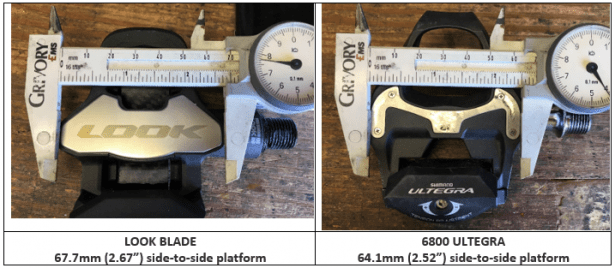LOOK KÉO BLADE REVIEW
-
Pedals
-
Cleats
Summary
Great lightweight pedals that come with 4.5° (float) cleats
Product: KÉO BLADE CARBON ANDRE GREIPEL
MSRP: view here
Source: Bike Shops, Websites
Supplied by: LOOK
Pros
- Pedal Spindles
- Carbon Pedal Body
- • Lightweight: 110 gr each or 288 gr per pair with cleats & screws
- • Stiff & Strong
- 700 mm2 surface area (cleat to pedal)
- Very EASY ingress, egress
• Strong Chromoly
• Low stack height – 13mm
Cons
- Personally, I’m used to 2 float cleats so these 4.5° float cleats took getting used to.
- Unlike KEO GRIP, these KEO CLEATs have no rubber traction so they are SLIPPERY.
User Review
( votes)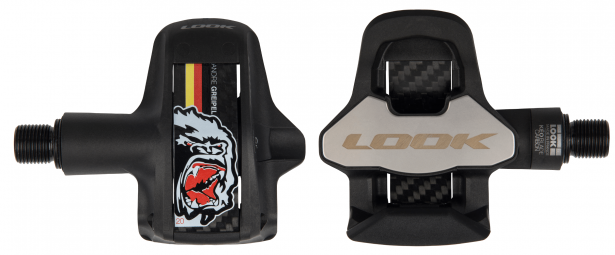
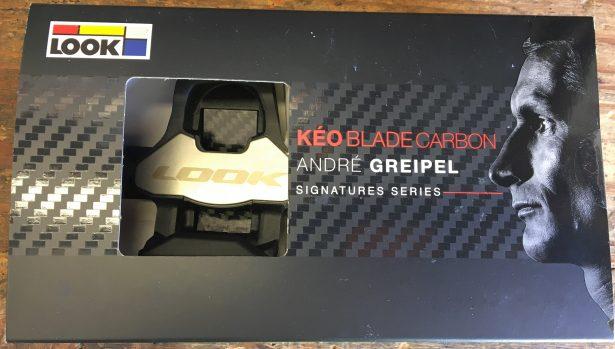
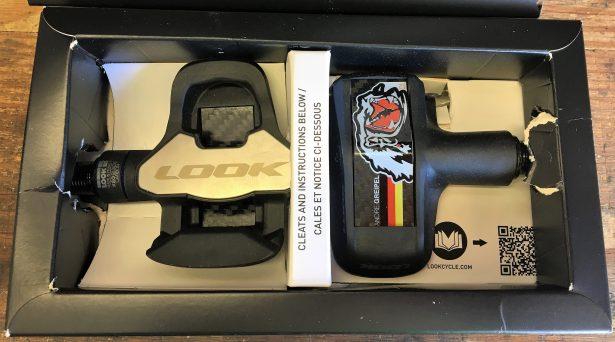
LOOK KÉO BLADE CARBON PEDALS ANDRE GREIPEL
For 2017, there are 4 basic KÉO pedal product lines;

IMPORTANT TECH
CLEAT TECHNOLOGY
Look offers 2 main road (racing) cleats in the KÉO product line. They are identical except one includes 2 anti-slip rubber grip pads (KÉO GRIP cleat), the other (KÉO CLEAT cleat) doesn’t.
Advantages/Disadvantages;
- KÉO GRIP – Anti-slip but slightly heavier
- KÉO CLEAT – Slippery when walking but lighter (less rotational weight)
KÉO CLEATs are included with these pedals. 
Note; there are holes for attaching the anti-slip rubber grippers so this tells me that they might be the same cleat but one is minus the anti-slip grippers.
The main drawback to the KÉO CLEATs is that they are incredibly slippery. You really need to watch your step when walking in these cleats. I highly recommend either the KÉO GRIP cleats or, for less than $10 pick up a set of cleat-covers – see link below.
CLEAT FLOAT
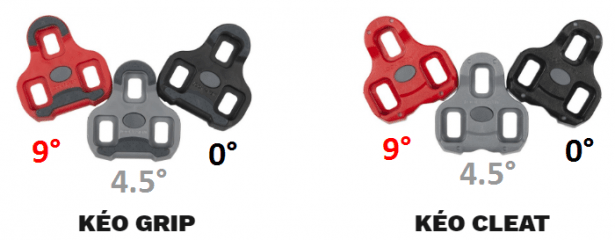
As a bike fitter in SoCal, I see a lot of pedals and cleats. Some in good condition, most need replacing. 90% of my clients have Shimano cleats, most come in with Yellow cleats and leave with Blue. 5% have LOOK, which about half are Red and half are Gray. 5% have Speedplay with half having adjustable cleats, the other half fixed. The table below shows cleat options for these 3 pedals. Note: Since I have not had any customers bring in a bike with TIME pedals, nor have I used them, I have not included them on this list.

My regular pedal/cleat is an Ultegra 6800/BLUE cleat. For those that have not had a bike/cleat fit, I recommend the maximum float that the manufacturer offers. This is because your local bike shop will install them for you, where a salesperson or mechanic will more than likely just slap them onto your shoes in any random direction. From a LBS salesperson, “if the cleats are pointing close to forward, they are good enough.”
After your bike fit from a certified bike-fitter (I recommend Trek Precision Fit – look 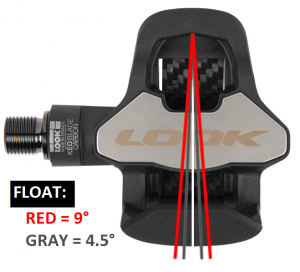 for a level 2 or BikeFit.com certified pedal/cleat certification), you can go with a minimal float cleat – minimal, not 0°. I am used to my 2° Shimano Blue cleats, so I was looking forward to testing out a pedal with more than 2° of float. At more than double my usual float, this should be interesting.
for a level 2 or BikeFit.com certified pedal/cleat certification), you can go with a minimal float cleat – minimal, not 0°. I am used to my 2° Shimano Blue cleats, so I was looking forward to testing out a pedal with more than 2° of float. At more than double my usual float, this should be interesting.
After several rides, I’m still not getting used to my feet moving around a little more than I’m used to. {Note: If you are used to Shimano Yellow 6° float, these 4.5° float cleats should work perfect for you.} One thing I had to adjust is the inward rotation.
I originally centered my cleats so I was in the middle of the float. But, personally, at 4.5° (that’s 2.25° each way), there is so much float, that from time to time, the back of my shoes would graze the crank arms and chainstays.
I had to readjust the cleats so that the shoes would not contact the crank arms nor the chainstays. Right now, my shoes can rotate heel-in 1.5° and rotate heel-out 3°. A lot of potential wasted movement in my opinion.
The picture above shows this pedal with cleat float superimposed. The red lines show how much 9° looks like, the gray lines show a total of 4.5° float and the white line represents the 0° float black cleats.
I would like to see LOOK make a cleat that is in-between their BLACK and GRAY. I think somewhere between 2° and 2.5° would be ideal, 2.5° would be perfect. I vote for green – that would be cool, a 2.5° GREEN cleat!
BLADE TECHNOLOGY
This pedal uses a carbon-fiber blade instead of a metal spring (see pictures below). This has many advantages for the cyclist:

EAST IN/OUT
• These are the easiest pedals I have ever used where your cleats pop-into the pedals without needing to look. The pedals are located at the perfect angle so when starting to roll after a red light, raise your foot and start pedaling. It’s an automatic movement. It’s unbelievable how easy it is to clip in and clip out. Comparing to Shimano SPD-SL pedals where I almost need to look down each time to get my foot into the pedal, these LOOK’s snap in with no effort at all!
RETENTION
• A slight drawback is that if you want to change the amount of snap in/retention pressure, you need to install a different carbon blade. Three blades are available for this pedal, two with the Andre Greipel logo; 12 Nm of force, 16 Nm of force, and a standard (non-logo) 20 Nm blade. I looked at mine and could not tell which version the pedal has without taking them completely apart, but, since it seems to be an easy in/out, I would guess the stock pedals come with the 12 Nm blades. Since the carbon will not fatigue, these blades should last many miles and many years.
• You know you are clipped in due to a definite SNAP. Once clipped in, the pedals hold a firm grip on the cleats. The only drawback is again the large amount of float I am not used to. I think 2.5° of float is more than adequate.
• If you wish to exchange the blades, it looks to be simple 15-minute job to swap blades in both pedals.
AERODYNAMICS
• If you look at the photos showing the underside of the pedals, the blades are perfectly integrated to make a totally smooth surface. I don’t think there’s a more aerodynamic pedal made!
LOW WEIGHT
• A pedal designed with a blade vs steel springs allows for a significant reduction in weight as well as better load distribution.
• With its carbon body and carbon blade retention, this is a very light pedal.
• They ‘could’ reduce weight with 2 modifications for this special edition pedal;
1. Titanium axle pedal (97 gm each) vs Chromoly Steel pedal (117 gm each) = 20 gm (0.7 oz.) savings
2. Skeletonize the steel floor plate (like Ultegra, Dura-Ace)
• Since this is a signature series pedal, no expense should be spared!
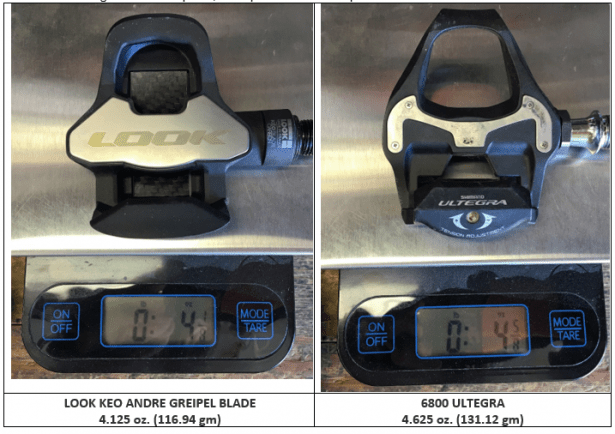
PEDAL SPINDLES (aka AXLES)
This pedal uses the Chromoly pedal spindle and is designed to net a very low stack height of only 13mm.
It is interesting to note that the Chromoly axle only adds 20g to each pedal.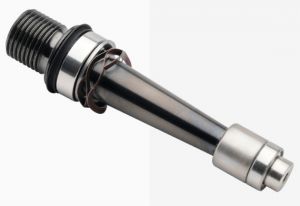
The pedal axle uses a combination of a cartridge needle bearing and two outboard ball bearings to distribute the load evenly. This also provides increased rigidity between the carbon pedal body and the length of the spindle which minimizes rotational friction and resistance. This pedal does feel smoooooooooth!
On LOOK’s website, they mention that their axles are approved only after a rotational test of 2 million cycles at 100 RPM with a load of 198.5 lbs. (90kg) on the center of the pedal and an eccentric rotation (creating a shock on each rotation). This is equivalent to a Mark Cavendish sprint at 1700 watts with 100 revolutions/min for 333 hours! This test far exceeds the current industry standard EN14781.
PEDAL SURFACE AREA
700 mm² cleat/pedal contact, wider, taller and more surface area means higher power transfer and less foot rocking.
HOW DO THEY RIDE?
Let me first say that I really like these pedals. I like the full carbon body and blade technology. It really works! These pedals are light, stiff and strong. With more surface area than a Shimano SPD-SL, there is absolutely no rocking back and forth of the feet. The downside again is the large (in my opinion) amount of float 4.5° which
o If not adjusted correctly, the back of your shoes can contact the crank arms as well as the chain stays
o Allows the shoes to wander heel-in/heel-out an excessive amount.
I think 2.5° float would be a great compromise.
I also like the fact that clipping into the pedals is the easiest I have ever experienced. My feet were always in line and all I had to do was get my cleat close to the pedal and it would snap-in, then just start pedaling and go. It’s really that simple and easy. No looking down and hunting around for where your pedals are.
RECOMMENDED?
YES, these pedals are as smooth as silk and provided maximum power transfer. They work and perform as advertised and, if they are good enough for the top sprinters in the World Tour, they are good enough for the rest of us!

I have always enjoyed bicycling and, through a series of coincidences, became a Bicycle Industry Consultant and Product Tester. I test prototype products for companies and have published only off the shelf production products on biketestreviews.com.



